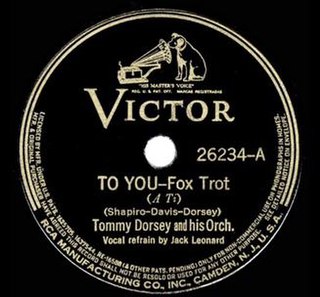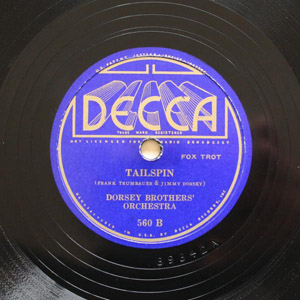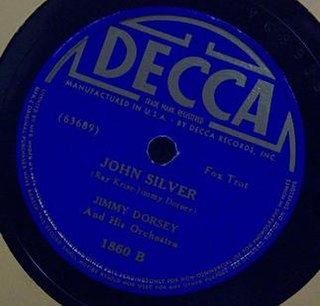"I'm Getting Sentimental Over You" is a song recorded by Tommy Dorsey and His Orchestra. The words were written by Ned Washington and the music was written by George Bassman. It was first performed in 1932. The original copyright is dated 1933 and issued to Lawrence Music Publishers, Inc. The copyright was assigned to Mills Music, Inc. in 1934. Noni Bernardi, a saxophonist with the Dorsey orchestra arranged this song.
"Imagination" is a popular song with music written by Jimmy Van Heusen and the lyrics by Johnny Burke. The song was first published in 1940. The two best-selling versions were recorded by the orchestras of Glenn Miller and Tommy Dorsey in 1940.

"I Don't Stand a Ghost of a Chance With You" is a 1932 song recorded by Bing Crosby with Orchestral Accompaniment. The music was composed by Victor Young, with lyrics written by Ned Washington and Bing Crosby. The song is a jazz and pop standard recorded by many different artists.
"So Rare" is a popular song published in 1937 by composer Jerry Herst and lyricist Jack Sharpe. It became a hit for Jimmy Dorsey in 1957.

"I'm Glad There Is You " is a song written by Jimmy Dorsey and Paul Madeira first published in 1941. It has become a jazz and pop standard.

Annie's Cousin Fannie, which is sometimes listed as "Annie's Cousin Fanny", is a 1934 song composed by Glenn Miller and recorded by The Dorsey Brothers Orchestra for Brunswick and Decca Records. The Dorsey Brothers released two versions of the song in 1934 and 1935.

"It's the Dreamer in Me" is a 1938 song composed by Jimmy Dorsey and Jimmy Van Heusen, which was first recorded by Jimmy Dorsey and His Orchestra with Bob Eberly on vocals. Jimmy Dorsey composed the music. The lyrics were written by Jimmy Van Heusen. The song is a jazz and pop standard.

Solo Hop is a 1935 instrumental composed by Glenn Miller and released as a Columbia 78 single. The recording was part of Glenn Miller's earliest sessions as a leader recording under his own name.

"To You" is a 1939 song composed by Tommy Dorsey with Benny Davis and Ted Shapiro. The song was a top 10 hit on the Billboard charts.

"You Taught Me to Love Again" is a 1939 song written and recorded by Tommy Dorsey and released as a 78 single.

"This Is No Dream" is a 1939 song co-written by Tommy Dorsey with Benny Davis and Ted Shapiro and released as a 78 single by his orchestra.

"In The Middle Of A Dream" is a 1939 song composed by Tommy Dorsey, Einar Swan, and Al Stillman. The song became a Top Ten hit in 1939 when released by Tommy Dorsey and His Orchestra.

Tailspin is a 1934 song written by Jimmy Dorsey and Frankie Trumbauer. The song was released by Paul Whiteman and His Orchestra featuring Frankie Trumbauer in 1934 on Victor and by The Dorsey Brothers Orchestra in 1935 as a Decca single.

"The Morning After" is a 1937 song composed by Tommy Dorsey, Moe Jaffe, and Clay Boland. Tommy Dorsey and His Orchestra released the song as a Victor 78 single in 1937 with Jack Leonard on vocals.

John Silver is a 1938 song written by Jimmy Dorsey with Ray Krise. Jimmy Dorsey and His Orchestra released the song as a 78 single on Decca in 1938.

"Pennsylvania 6-5000" is a 1940 swing jazz and pop standard with music by Jerry Gray and lyrics by Carl Sigman. It was recorded by Glenn Miller and His Orchestra as a Bluebird 78 rpm single.

"Tomorrow's Another Day" is a 1935 song composed by Glenn Miller for the Dorsey Brothers Orchestra. The song was released as a 78 single by the Dorsey Brothers Orchestra on Decca Records.

"Singin' the Blues" is a 1920 jazz composition by J. Russel Robinson, Con Conrad, Sam M. Lewis, and Joe Young. It was recorded by the Original Dixieland Jass Band in 1920 as an instrumental and released as a Victor 78 as part of a medley with "Margie". The song was released with lyrics by vocalist Aileen Stanley in 1920 on Victor. In 1927, Frank Trumbauer, Bix Beiderbecke, and Eddie Lang recorded and released the song as an Okeh 78. The Trumbauer recording is considered a jazz and pop standard, greatly contributing to Frank Trumbauer and Bix Beiderbecke's reputation and influence. It is not related to the 1956 pop song "Singing the Blues" first recorded and released by Marty Robbins in 1956.



















